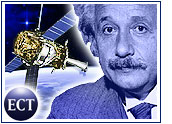
Is it an urban myth, or is it really true that NASA sent the first men to the moon with less computing power than what sits inside today’s average desktop? The answer largely depends on how you define “computing power.” But however you define it, today’s typical PC packs more punch than a 1960s mainframe.
Back in the slide-rule days, space flight and information technology were in their relative infancy. But they were, so to speak, a match made in heaven. Few human activities rely more completely on IT than the exploration of space.
Today, IT finds a home in virtually every corner of the projects that make NASA unique. Support for space missions alone — the International Space Station, the space shuttle, planetary probes and Earth satellites — can involve materials research, software, guidance systems, monitoring systems, scientific experiments and data analysis. And all of these project elements are IT intensive.
NASA has plenty of non-space projects too, from aeronautics to biology. There was also a significant IT effort involved in analyzing the Columbia shuttle catastrophe.
Close to the Edge
Information management is also vital to the administrative and communications tasks NASA shares with other large organizations, such as the vendors from which NASA acquires its equipment. Headquartered in Washington, D.C., NASA has more than 10 centers from coast to coast. Each center works on different projects or on different parts of the same project. Each also pursues its own philosophies and goals and, to a great degree, conducts its own IT efforts.
However, despite this complex and unique synergy, NASA has been operating under stress for some time. John Logsden, a member of the Columbia Accident Investigation Board, commented at the debut of its report on the shuttle accident: “To fund other parts of the NASA program, the shuttle program was squeezed during the ’90s. Its budget was cut by 40 percent. Its workforce was cut by 40 percent. That left too little margin for robust operation of the system in our judgment. It was operating too close to too many margins.”
The falling foam that the board concluded was the definite cause of the disaster was not, of course, an IT component, and no direct criticism has been aimed at NASA’s IT developments or those of its contractors. But has budget squeeze affected the organization’s performance or hampered its progress?
Justifying IT
Certainly, it has been true that, as in the private sector, the case for IT buying and expansion is no longer taken for granted. “The Office of Management and Budget has been very clear that they want to see business cases,” said Brian Dunbar, NASA’s Internet services manager.
“You do have to justify,” he told TechNewsWorld. “How does this affect the main lines of business? Are there savings down the road? Will this investment be an add-on, or will it replace something?”
Another factor that will affect the future of IT within NASA is the ongoing debate over using robotic missions instead of human-staffed missions. Whether one camp or the other gains influence will determine both the nature and the amount of IT development and spending in the future.
Internet in Orbit
Indeed, some of the most profound and interesting NASA projects don’t involve the glamour of staffed missions at all, but are projects designed to test Earth technologies in space or explore the nature of the universe.
The Communication And Navigation Demonstration on Shuttle (CANDOS) mission, for example, flew aboard a recent flight. One of its objectives was to test the functionality of the Internet in space. Control tasks, telemetry, software updates by FTP and other tests were all successfully carried out between the shuttle and ground stations using standard Internet protocols.
On December 6th of this year, a Delta II launch vehicle will lift Gravity Probe B — a joint project between NASA and Stanford University — into polar orbit. The project, which uses absolutely state-of-the-art physics — and, by definition, is computing-intensive — will test two predictions arising from the theory of relativity by measuring “how space and time are warped by the presence of the Earth, and, more profoundly, how the Earth’s rotation drags space-time around with it.”
Less esoteric but still critical to the future of the shuttle was the use of IT in discovering what caused Columbia to break apart. Here, investigators employed IT in wing-load assessment, materials analysis and simulated airflow modeling.
Down to Earth
While the field centers run science and engineering IT projects individually, NASA must still be administered as a large nationwide organization. Perhaps the least dramatic — but most complex — use of IT in NASA is, according to Brian Dunbar, sharing information and working together as a single organization. NASA runs a huge mix of computers and software, including major operating systems like Windows, Macintosh and Unix.
Until recently, different financial systems were used across NASA, wastefully duplicating the management of human resources, purchasing, payroll, travel and more. Now, however, NASA is building a modular Integrated Financial Management Program (IFMP) that, according to program executive Patrick Ciganer, “allows us to work with common tools toward common goals, not as 10 different centers with different ways of budgeting or managing their finances.”
One of IFMP’s first parts, the Core Financial Module, replaced 145 legacy systems across the agency.
Private Sector
Like other scientific government agencies, NASA views part of its mission as the transfer of new technologies to the private sector. In the past, NASA has brought us inventions as diverse as barcode scanners, smoke detectors and rotary blood pumps, not to mention the credit it shares with ARPA and universities for the Internet.
In a current example from the Gravity Probe B project, Stanford University graduate students improved the precision of civilian Global Positioning Systems to centimeter-level accuracy. This development is expected to spin off to things like automated tractors and aircraft-landing systems.
And the future? “We really want to improve our ability for people to collaborate across the NASA Centers,” said Dunbar. “In the past, our centers have been kind of competitive for particular pieces of work, but NASA’s administrator wants them to be collaborators.”
Providing the NASA centers and headquarters with tools that allow people to collaborate, Dunbar added, therefore is an important priority.










































